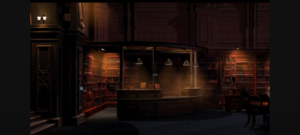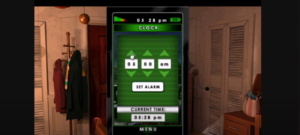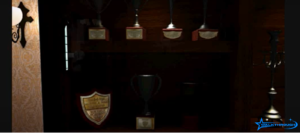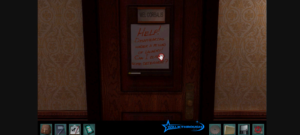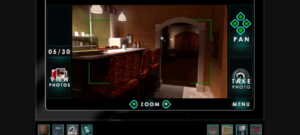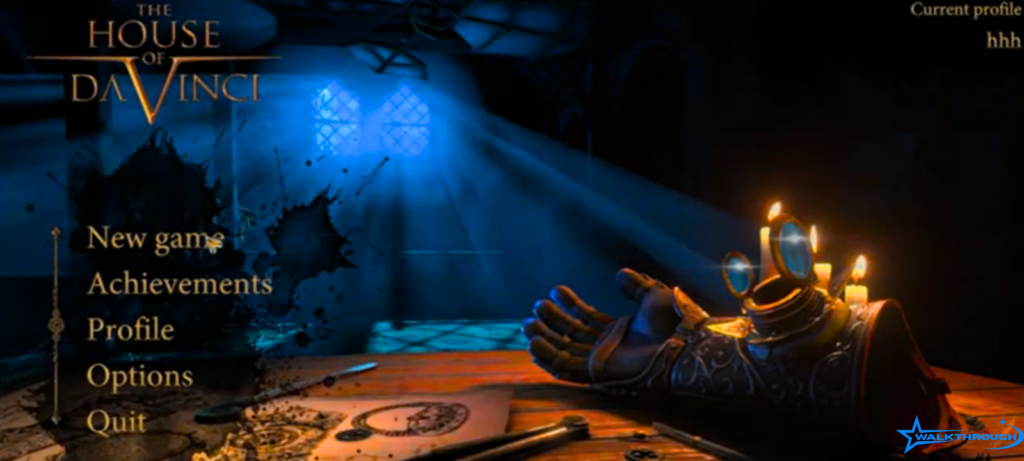
🎮 Introduction to The House of Da Vinci
The House of Da Vinci is a critically acclaimed 3D puzzle adventure game set in the heart of Renaissance Italy. Inspired by the works of Leonardo da Vinci, the game immerses you in a world full of mysterious inventions, hidden passageways, and clever contraptions. Developed by Blue Brain Games, this title challenges players to explore rooms filled with intricate mechanical puzzles, all while uncovering the secrets left behind by the missing genius himself.
📜 Game Overview & Storyline
You play as the apprentice of Leonardo da Vinci, who has suddenly vanished under suspicious circumstances. Your mission is to retrace his steps, uncover his inventions, and decode the cryptic messages he left behind. Each room holds fragments of the truth and unlocking them reveals more than just gears and gadgets. As you progress, you’ll find that the story is just as layered as the puzzles themselves.
🕹️ Gameplay Mechanics & Controls
- Touch or Mouse Controls: The game is designed for intuitive interactions. Rotate, slide, and manipulate objects using touch gestures or your mouse.
- Zoom & Rotate: Double-tap or scroll in to zoom on objects; rotate them to reveal hidden compartments.
- Inventory Bar: Any object you collect is stored in your inventory items often need to be examined or combined.
- Environmental Awareness: Everything around you could be a clue. Watch for glimmers, unusual patterns, or mechanical sounds.
✅ Tips for First-Time Players
- Observe Everything: The game rewards attention to detail. Turn objects around. Look at them from different angles.
- Use the Oculus Lens Often: When stuck, try using the lens to see things that are invisible to the naked eye.
- Don’t Rush Puzzles: Take your time. Most solutions make logical sense once you observe all available elements.
- Replay Mechanisms If Needed: Many contraptions can be reset or reactivated don’t hesitate to backtrack slightly.
- Keep Notes: Writing down symbols or sequences can save time, especially in later levels.
👁️ The Use of the Oculus Lens
The Oculus Lens is your primary tool for uncovering hidden secrets. It lets you:
- Reveal hidden symbols and energy trails
- Detect clues not visible to the naked eye
- Solve lens-based puzzles involving invisible mechanisms
Make it a habit to scan the room with the lens whenever you’re unsure where to go next.
🧩 Manipulating Mechanical Objects
Mechanical puzzles are the heart of the game. You’ll encounter:
- Levers, knobs, gears, and dials
- Sliding panels and rotating discs
- Layered mechanisms with multiple phases
Success often means interacting with objects in a specific order. If something doesn’t move, you may be missing a piece or activating it from the wrong direction.
🧠 Puzzle Types You’ll Encounter
- Mechanical Logic Puzzles – Involving levers, switches, and gears
- Combination Locks – Often require clues from notes or surroundings
- Object Assembly – Combine or manipulate inventory items
- Symbol Matching – Match runes, patterns, or colors
- Light & Optics Puzzles – Use lenses and mirrors to reveal solutions
📦 Inventory System Explained
- Collected items automatically go into your inventory.
- You can examine items by rotating them some objects contain hidden parts inside.
- Many puzzles require item combination, like attaching a handle to a gear or inserting a key part into a slot.
🔎 Clues & Environmental Interaction
Clues are often blended into the environment. Look for:
- Engraved numbers
- Symbols etched into wood or stone
- Notes or scrolls with riddle-like hints
Some clues only appear after solving another puzzle progression is layered intentionally.
💾 Saving Progress and Game Navigation
- The game uses an auto-save system.
- You can restart a puzzle or return to the previous room via the pause menu.
- Don’t worry about making mistakes the game is forgiving and allows for easy resets.
🧩 Complete Chapter Walkthrough Overview
🏙️ Street
The game opens on a quiet cobblestone street shrouded in mystery. Your journey begins with exploration and observation look for signs of hidden mechanisms on walls, behind crates, and under loose bricks. Use your Oculus Lens to reveal invisible markings and glyphs on the environment. Early puzzles introduce you to object manipulation and spatial awareness. One key challenge includes finding a passcode to unlock a hidden door, which involves assembling fragments of a torn note and decoding symbols. This chapter sets the tone with an eerie atmosphere and teaches you how to interact with intricate devices a core mechanic throughout the game.
📚 Library
Inside the library, things become more cerebral. You’re surrounded by ancient books, scrolls, and curious contraptions. This chapter is rich in lore you’ll discover notes and letters that give insight into Leonardo’s experiments. The centerpiece puzzle involves a rotating bookshelf mechanism that hides a key compartment. Be sure to examine books with unusual spines, as many contain levers or symbols essential to unlocking new areas. There’s also a hidden astrological puzzle requiring you to align planets in a star chart, only solvable by clues hidden behind paintings and in coded manuscripts. The Oculus Lens reveals secrets written in invisible ink, moving the story deeper into da Vinci’s secret world.
🔧 Workshop
Leonardo’s workshop is a mechanical wonderland. Full of strange devices, toolkits, and half-assembled inventions, this chapter tests your problem-solving abilities. A central focus here is assembling and calibrating a prototype machine using scattered gears, belts, and crank mechanisms. One of the standout moments involves reconstructing a mechanical hand and programming it to perform a specific movement to unlock a hidden vault. Inventory items must be combined and adjusted like modifying tools before they can be used in machines. You’ll also encounter puzzles that use the principles of leverage and pressure, further immersing you in Leonardo’s engineering genius.
🏡 Courtyard
The courtyard shifts the setting to an outdoor puzzle space. It features a large sundial, a well, and various stone statues each part of a larger, interconnected mechanism. Begin by analyzing the sundial; its shadow points toward different objects as you rotate time-based markers. The Oculus Lens helps highlight ancient glyphs on the ground and walls. You’ll need to manipulate the water system by redirecting flow from the well using underground levers and cistern keys. A particularly clever challenge involves synchronizing statue poses to match clues from a fragmented fresco. Solving the final courtyard puzzle reveals a hidden passage leading underground into the crypt.
⚰️ Crypt
Dark and eerie, the crypt introduces a somber tone with puzzles based around tombs, skeletal figures, and spiritual symbols. Start by examining the sarcophagi closely many of them have sliding panels or compartments activated by hidden switches. A key puzzle involves aligning stone runes in a rotating sequence to match a sacred symbol combination found in an ancient scroll. Some coffins house gear parts or levers that must be combined to open deeper chambers. The Oculus Lens becomes critical in revealing ghostly blueprints and spiritual traces. One of the most striking puzzles is a bone mechanism, where skeletal arms must be placed in specific positions to unlock the next area.
🛡️ Armory
In the armory, you’re surrounded by medieval weapons, suits of armor, and defense systems. The puzzles here involve combat mechanics without any actual fighting. You’ll work through a crossbow assembly puzzle, where you find, clean, and reattach parts of a historical weapon to trigger a secret door. Examine shields and armor pieces many hide emblems or embedded keys. There’s also a hidden mechanism inside a knight statue that activates a series of rotating gears in the floor. Be cautious with the trapdoor puzzle it’s a multi-phase test involving pressure plates and exact sequencing. The deeper you go, the closer you get to unlocking the final secrets.
🗼 Tower
Ascent into the tower brings back verticality and vision-based challenges. The environment is more exposed, with moving gears, levers, and wind-powered machines. The central puzzle involves a massive rotating telescope, which must be realigned using clues from star maps and navigation charts found earlier. This chapter emphasizes timing and rotation be prepared to line up rotating platforms and redirect energy between conduits. You’ll also encounter a puzzle that uses light reflection, where you need to position glass prisms at exact angles. Climbing higher, you’ll eventually activate the time portal, revealing Leonardo’s final invention.
⏳ Time Machine (END)
The final chapter, and the most mind-bending, revolves around Leonardo’s time machine. This ancient invention uses futuristic mechanics, requiring full use of everything you’ve learned. Start by arranging power sources into correct positions using a magnetic polarity puzzle. Then, input coordinates using rotating discs engraved with ancient numbers and symbols. A dramatic multi-step puzzle follows, where you must sync gears, levers, and crystals to stabilize the portal. As you align time vectors and lock the sequence, the room transforms into a visually stunning array of colors and light. The game ends with a cryptic but emotionally powerful cinematic, hinting at Leonardo’s message to the future and your role in preserving it.
🎁 Bonus Puzzle Solutions (If Applicable)
Throughout the game, you may encounter optional puzzles hidden in the environment. These are not required to complete the game but provide extra lore and challenge. Examples include:
- Hidden compartments inside drawers already solved
- Secondary symbol puzzles only visible with the Oculus Lens
- Rotating sculpture puzzles that grant achievement rewards
One of the hidden puzzles includes a gear assembly on the back of a bookshelf that leads to a secret letter from Leonardo. Another is a mirror reflection riddle that unlocks a mysterious quote related to the overall story. Solving these adds depth and a sense of accomplishment for completionists.
🏆 Achievements Guide
Throughout The House of Da Vinci, players can unlock a variety of achievements some tied to story progression, while others reward exploration and clever thinking. Key story-based achievements are awarded upon completing each chapter. However, optional achievements include solving hidden puzzles, finishing chapters under a certain time, and discovering secret notes left by Leonardo.
One notable achievement requires players to solve a puzzle without using the Oculus Lens, which can be tricky but rewarding. Another hidden achievement involves interacting with a specific object in each chapter like turning a statue’s head or lifting a rug. If you’re aiming for 100% completion, replaying chapters is essential to uncover what you may have missed.
You can also check our other walkthrough
❓ Frequently Asked Questions (FAQs)
Q: Is the game linear, or can I explore freely?
The game is mostly linear, with each chapter unlocking after completing the previous one. However, within chapters, you’re free to explore puzzles in a semi-open sequence.
Q: I’m stuck even with the Oculus Lens what should I do?
Double-check interactive objects and rotate items in your inventory. Often, objects need to be examined and manipulated (turned, extended, opened) to progress.
Q: Are there multiple endings?
The House of Da Vinci has a single ending, but there are secrets and lore scattered throughout the game that offer deeper context to the story if discovered.
Q: Can I replay chapters?
Yes, once unlocked, chapters can be replayed from the main menu. This is helpful for achievement hunters or players wanting to re-experience specific puzzles.
📖 Story Recap & Interpretation
At its heart, The House of Da Vinci is about a brilliant apprentice unraveling the mysterious disappearance of his master. While most of the storytelling is environmental and visual, piecing together notes, devices, and cryptic messages reveals a layered narrative. Leonardo feared for his life and hid messages to guide his apprentice through danger and secrets he couldn’t openly share.
As you progress, the puzzles become metaphors for unlocking deeper truths not just mechanical, but philosophical. The presence of coded letters, symbolic artifacts, and ancient devices ties into a broader theme of knowledge preservation in a time of political turmoil. By the end, you’re not just solving puzzles you’re stepping into Leonardo’s mind.
🧠 Final Thoughts & Replayability
The House of Da Vinci offers a deeply immersive puzzle experience with a rich atmosphere and clever mechanics. The blend of historical inspiration with intricate puzzle design keeps players engaged from start to finish. Even after completing the main storyline, the game offers high replay value through:
- Missed collectibles and secrets
- Optional puzzles and achievements
- Lore discoveries hidden in plain sight
The game is perfect for fans of The Room series and anyone who enjoys intellectually satisfying puzzle adventures. Whether you’re here for the story, the mind-bending mechanics, or the stunning visuals, this walkthrough ensures you’ll experience everything the game has to offer without getting stuck or missing hidden gems.

